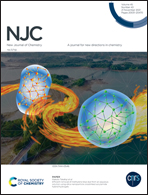Design for dynamic hydrogen bonding in a double network structure to improve the mechanical properties of sodium alginate fibers
Abstract
In order to improve the mechanical properties of sodium alginate (SA) fibers, a dynamic hydrogen bonding linked double network structure formed using vinyl-functionalised silicon-based nanoparticles (VSNP) was designed. In the absence of a cross-linking agent, VSNP could not only polymerize with the acrylic acid (AA) monomers to form linear long chains using active double bonds, but also with the pseudo cross-link polyacrylic acid (PAA) chains to generate an analogous chemical cross-linked network. SA and Ca2+ formed an ionic cross-linked second network through chelation. The VSNP connected the two networks using dynamic hydrogen bonding. The mechanical properties of the SA fibers were significantly improved based on the energy dissipation effect of the double network structure and the destruction, rearrangement and reorganization of the dynamic hydrogen bonding. The breaking strength and breaking elongation of the SA/PAA-VSNP fibers reached 3.68 cN per dtex and 13.65%, which were 83.08% and 65.45% greater than those of the pure SA fiber, respectively. The introduction of VSNP broke the hydrogen bonds between the SA molecular chains, which reduced the viscosity of the spinning solution and improved the spinning performance. The SA/PAA-VSNP fiber had a good crystallization performance, a denser micro-structure, an excellent hygroscopicity and demonstrated heat resistance.



 Please wait while we load your content...
Please wait while we load your content...